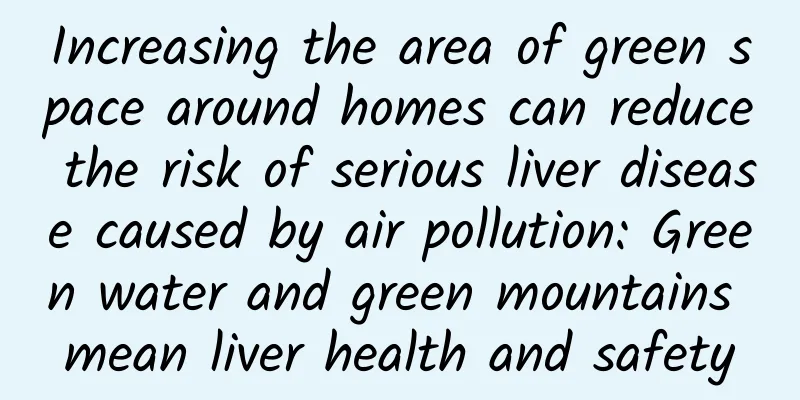Increasing the area of green space around homes can reduce the risk of serious liver disease caused by air pollution: Green water and green mountains mean liver health and safety

|
Approximately 2 million people die from liver disease each year, accounting for 3.5% of global deaths, of which approximately 1 million die from complications of cirrhosis and approximately 1 million die from viral hepatitis and hepatocellular carcinoma. Identifying and determining more modifiable risk factors to strengthen the prevention of severe liver diseases such as cirrhosis, liver failure, and hepatocellular carcinoma has important clinical and public health value. However, to date, no study has systematically evaluated the association between important environmental factors, including air pollution and the amount of green space around residential areas, and severe liver disease. Based on the above problems, researchers from Nanfang Hospital of Southern Medical University published a study titled "Various ambient air pollutants, residential green spaces, fibrosis 4 scores, genetic susceptibility, and risk of severe liver disease" in Ecotoxicology and environmental safety . Professor Sun Jian and Professor Qin Xianhui from Nanfang Hospital of Southern Medical University are the co-corresponding authors of the article, and Dr. Ye Ziliang is the first author. The study showed that the degree of air pollution was positively correlated with the risk of severe liver disease, while the area of green space around the residence was negatively correlated with the risk of severe liver disease. Increasing the area of green space around the residence can significantly weaken the positive correlation between air pollution and the risk of severe liver disease. The study is a prospective cohort study based on the UK Biobank, which included 427,697 participants without liver disease at baseline. The primary endpoint of the study was new severe liver disease, including compensated and uncompensated cirrhosis, liver failure and hepatocellular carcinoma. The study used air pollution scores to comprehensively evaluate air pollution conditions, including pollution from particulate matter and nitrogen oxides. The average air pollution score was 25.3 (standard deviation: 7.2) μg/m3, and the average proportion of greenery within 1000 meters around the participants' homes was 45.1% (standard deviation: 21.6%). Figure 1. Correlation between air pollution, green living environment and severe liver disease After 12.0 years of follow-up, 4,571 participants developed severe liver disease. The study showed that for every 7.2 μg/m3 increase in air pollution score, the risk of severe liver disease increased significantly by 7%. And for every 21.6% increase in the proportion of greenery within 1,000 meters around the residence, the risk of severe liver disease decreased significantly by 5% (Figure 1). Figure 2. Figure 2. Stratified Analysis of Air Pollution and Severe Liver Disease. Further stratified analysis found that an increase in the proportion of greenery around residential areas significantly reduced the risk of severe liver disease caused by air pollution. In addition, the study also found that liver fibrosis score (FIB-4), blood pressure status and smoking status also affect the association between air pollution and severe liver disease, that is, maintaining liver fibrosis score, normal blood pressure and not smoking may also reduce the risk of severe liver disease caused by air pollution (Figure 2). (Pictures from the Internet, copyright belongs to the original author) In conclusion, this study provides new evidence for the relationship between environmental pollution, residential greenery and the risk of severe liver disease. The results call for attention to the impact of environmental pollution and residential green space on health. At the same time, the study also emphasizes the important synergistic role of liver fibrosis, hypertension, smoking and air pollution in causing severe liver disease, providing new ideas and clues for future related research. References: Ye, Z., Liu, M., He, P., Wu, Q., Yang, S., Zhang, Y., Zhou, C., Zhang, Y., Gan, X., Sun, J., & Qin, X. (2023). Various ambient air pollutants, residential green spaces, fibrosis 4 scores, genetic susceptibility, and risk of severe liver disease. Ecotoxicology and environmental safety, 263, 115246. Advance online publication. Editor | Ye Ziliang Xianghao Audit | Qin Xianhui Reprint: Please contact us and indicate the source. |
>>: Flu occurs every year, why is it so severe this year?
Recommend
What are the consequences of premature menopause? These disadvantages are scary.
Some women are physically weak and have poor resi...
Three kinds of stomach-nourishing foods, delicious and nutritious
Nowadays, due to the fast pace and pressure of li...
Pregnant women's blood routine neutrophil count is high
Pregnant women must undergo multiple examinations...
Should pregnant women take iron supplements in the morning or at night?
We often see various iron supplements in some out...
What is the effect of Fufang Xuanju Capsule for women?
One of the main ingredients of the Jizi Xuanju Ca...
What causes itchy pubic hair in women?
Married women must have experienced itching in th...
Why do some people suffer from severe pain due to high uric acid levels while others have no symptoms?
Expert of this article: Zhu Hongjian, Chief Physi...
How to relieve the pain of dysmenorrhea
Taking care of yourself during menstruation is pa...
Bleeding after 6 days of menstruation
Female friends all know that our menstrual period...
Introduction to postpartum episiotomy care methods
Many women who have had a normal delivery are ver...
Fetal development at one month of pregnancy
Children are gifts given by God to people. Many m...
Do you need to marinate sweet and sour fish in advance? How to marinate sweet and sour fish better?
Sweet and sour fish is sweet and delicious, with ...
Can corn silk water lower blood pressure and blood sugar? Be careful if you eat it wrong, or the blood pressure will get even higher!
"Corn silk water can 'diuretic and blood...
What to do if you have dental neuralgia during lactation
During breastfeeding, if you experience tooth neu...
What is breast hyperplasia
Nowadays, due to the active publicity of breast d...









